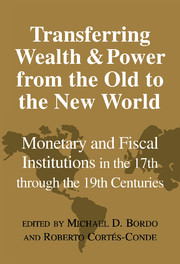 Transferring Wealth and Power from the Old to the New World
Transferring Wealth and Power from the Old to the New World Published online by Cambridge University Press: 27 March 2010
INTRODUCTION
Long before abdicating, Charles V addressed the following prophetic words to his son and prospective heir, Prince Philip: “Financial matters will be left in such a state that you will have a lot of work.” The same could have been declared by every Spanish Habsburg monarch to his respective successor. It is said that Charles's abdication was motivated by financial troubles, and from then on, for more than a century, things became only worse.
The root cause of the financial problem was, as in most European nations of the time – and perhaps of all times – war. In peacetime the resources of the Spanish Crown were amply sufficient to cover expenses; the trouble was that peaceful years were the exception. At the end of Charles's reign, peacetime expenditure was only one half of ordinary revenue: even admitting that there was already a heavy burden of debt, a hypothetical budget would have been in balance. War upset all calculations. From the moment he spent a small borrowed fortune bribing the imperial electors, Emperor Charles was involved in wars on several fronts: against France over Italy in the 1520s, against the Turks in the Mediterranean in the 1530s, and then against the Protestants in Germany in the 1540s and 1550s. In spite of the wealth of his domains, ordinary revenue could not finance this continuous war effort, and he had to have recourse to credit.
To save this book to your Kindle, first ensure no-reply@cambridge.org is added to your Approved Personal Document E-mail List under your Personal Document Settings on the Manage Your Content and Devices page of your Amazon account. Then enter the ‘name’ part of your Kindle email address below. Find out more about saving to your Kindle.
Note you can select to save to either the @free.kindle.com or @kindle.com variations. ‘@free.kindle.com’ emails are free but can only be saved to your device when it is connected to wi-fi. ‘@kindle.com’ emails can be delivered even when you are not connected to wi-fi, but note that service fees apply.
Find out more about the Kindle Personal Document Service.
To save content items to your account, please confirm that you agree to abide by our usage policies. If this is the first time you use this feature, you will be asked to authorise Cambridge Core to connect with your account. Find out more about saving content to Dropbox.
To save content items to your account, please confirm that you agree to abide by our usage policies. If this is the first time you use this feature, you will be asked to authorise Cambridge Core to connect with your account. Find out more about saving content to Google Drive.